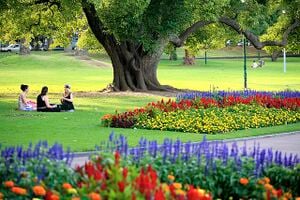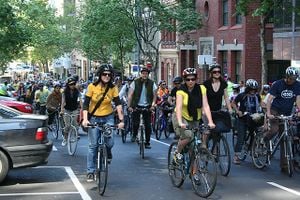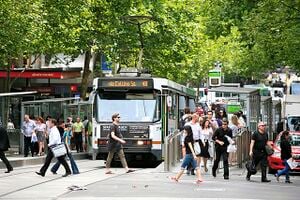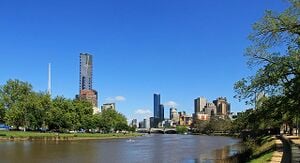
 Kerbside ferns and vertical gardens: transforming Melbourne’s ‘grotty’ laneways into urban oases, theguardian.com (Aug 04, 2023)
Kerbside ferns and vertical gardens: transforming Melbourne’s ‘grotty’ laneways into urban oases, theguardian.com (Aug 04, 2023)
Networks and sustainability initiatives[edit | edit source]
Melbourne, like other large cities, has multiple sustainability initiatives going on. Some of these are:
- Melbourne Sustainable Transport Reform
- How Melbourne Is Selling Commercial Property Owners on Green Retrofits, Henry Grabar, The Atlantic Cities.
In 2014, a new deliberative democratic forum, The Future Melbourne Network, was launched to discuss options and solutions to major challenges facing Melbourne, in areas such as housing, transport, and including issues such as climate change.
See also the external links to high-level projects below.
Climate action[edit | edit source]
Zero Net Emissions, information from the City of Melbourne. The City has set an ambitious target for Melbourne to become a carbon neutral city by 2020.
Open spaces[edit | edit source]
Wikipedia: Parks and gardens of Melbourne: Melbourne is considered to be Australia's garden city, and Victoria as the Garden State. There is an abundance of parks and gardens close to the CBD (Central Business District) with a variety of common and rare plant species amid landscaped vistas, pedestrian pathways, and tree lined avenues. Many regional towns have well tended botanic gardens, parks and tree lined avenues.
Trees, woodland and forest[edit | edit source]
Melbourne's Urban Forest, information from the City of Melbourne
Cycling activism[edit | edit source]

Critical Mass bicycle rides in Melbourne
Wikipedia:
- Cycling in Melbourne is common for recreation, commuting and sport. The city has an extensive network of off-road bicycle paths, as well as designated bicycle lanes on many streets. There is an active cycling culture enhanced by a relatively flat topography, and a generally mild climate.
- In the 21st century, cycling for health, fitness, and as a non-polluting alternative to the automobile has begun to increase in popularity once again, though cycling's transport modal share still accounts for only around 2% of all trips throughout the metropolitan area.
- In the Central Business District (population appx 70K) figures put cycling at 8% of all peak-hour (7am-10am) commuter traffic. Planning for improvements to CBD bicycles routes and other major arterial routes is underway.
- Bike paths in Melbourne: Bike paths around Melbourne have developed since the campaigns of Bicycle Network and the strong awareness that nine editions of the Bike Paths Guides have created of the network. Since with increased recognition from all levels of government of the benefit of cycling activities, Melbourne today has a comprehensive set of shared bicycle trails along its river and creek systems, next to its freeways and along its train lines.
- The length of the trails in Melbourne, as of 2014, totals around 1,900 km. It is possible to cycle from Werribee in the west to Research in the east (approx 62 km) and Craigieburn in the north and Seaford in the south (about 78 km) and points in between and only have to travel on the occasional piece of road. Often passing through relaxed park surrounds, cycling on many of Melbourne's bike paths can feel like a day out in the country despite remaining within metropolitan Melbourne. Melbourne's bike paths are often easily accessed from its train system.
- The latest 2014 edition of the Bike Paths and Rail Trail Guide shows the complete metro network in great detail together with path descriptions and more than 18 destination country rail trails. (www.bikepaths.com.au)
- Melbourne Bike Share is a bicycle sharing system that serves the central business district. The stations and bicycles are owned by the government and operated in a public-private partnership with Alta Bicycle Share. Launched in 2010, the network utilizes a system designed by Montreal-based Bixi with 600 bicycles operating from 51 stations. Melbourne Bike Share is one of two such systems in Australia.
- Melbourne Bike Share has experienced low ridership in comparison to other bicycle sharing networks in operation around the world. As of May 2011, users made about 13,000 trips each month, short of the goal of 25,000 trips per month. Observers have noted that local law requires all cyclists to wear helmets, which suppresses the number of people who can regularly use the system. Melbourne and Brisbane are the only cities in the world with a bicycle sharing network that have a mandatory helmet law. In November 2010, the Victoria state government began offering helmet rentals at selected stations in an attempt to increase both ridership and helmet usage.
- To counter continued poor usage, the Victorian Government decided in May 2013 to trial free helmet sharing by attaching the helmets to the handlebars of a portion of the bike share fleet.
Food activism[edit | edit source]
Veg Out community gardens, Melbourne
- FareShare (Australia) is an Australian not-for-profit organisation that provides healthy meals for Melbourne's hungry and homeless, using quality food that would otherwise be wasted. In 2008, FareShare rescued 280 tonnes of food from 80 businesses. More than 1,000 volunteers helped give away 560,000 meals for 106 charities. FareShare aims to give away one million meals this year.
- To produce FareShare's meals, it collects quality surplus food that would otherwise be wasted - from growers, manufacturers, wholesale markets, caterers, major retailers and hospitality schools - and turns it into nutritious meals. FareShare also redistributes a large quantity of uncooked food directly to more than 100 local charities.
- FareShare estimates that for every kilogram of food that is recovered, it saves 56 litres of water. Its food recovery activities in 2008-09 are also expected to save 620 tonnes of greenhouse gas – the equivalent to switching off 953 refrigerators a year. W
HerbShare, project in Melbourne to bring neighbours together to create a new food commons by mapping herbs and other food growing in front yards and public areas, on facebook
Sharing[edit | edit source]
Maps: Melbourne Sharing City
Sustainable transport activism[edit | edit source]
See also: Melbourne Sustainable Transport Reform

Wikipedia:
- Melbourne, Public transport: Melbourne is served by a public transport system integrating rail, tram and bus services. Its extensive tram network is the largest in the world, integrated into both bus and train networks. Almost 300 bus routes and a train system comprising 16 lines service Melbourne, Greater Melbourne and suburban regions. Metropolitan, rural and interstate railway networks link together at Southern Cross Station, in Melbourne's CBD (Central Business District).
- Trams in Melbourne: The tramway network is a major form of public transport in Melbourne. As of May 2014, the network consisted of 250 kilometres of track, 493 trams, 25 routes, and 1,763 tram stops. It is the largest urban tramway network in the world, ahead of the networks in St. Petersburg (240 km), Berlin (190 km), Moscow (181 km) and Vienna (172 km). Trams are the second most used form of public transport in overall boardings in Melbourne after the commuter railway network, with a total of 182.7 million passenger trips in 2012/13.

Resources[edit | edit source]
Video[edit | edit source]
Citizens data initiative[edit | edit source]
City of Melbourne Open Data portal
Other resources[edit | edit source]
- Sustainability information from the City of Melbourne
Past events[edit | edit source]
2015
December 11 festival21, all-day celebration of community, food and future.
February 7 - 28 The Melbourne Sustainable Living Festival/Foundation, held annually every February.
News and comment[edit | edit source]
2019
Regenerating forgotten urban places: 3000acres, Feb 11[1]
Melbourne becomes first city with all council infrastructure powered by renewables, Jan 16[2]
2017
Stressed street trees: mapping the urban forests to save them – and us, Mar 27[3]
Melbourne's trams to be solar powered, Jan 19[4]
2016
Climate change: Melbourne renewable energy project provides global blueprint, Jun 10[5]
Melbourne plan to make 25% of trips by bicycle 'ambitious but achievable', March 11[6]
Fruit and vegetable gardens turn Melbourne into edible city, Mar 6[7]
Context[edit | edit source]
Melbourne has a temperate climate with changeable weather and frequent winds. Suitable urban design for these conditions must include windbreaks and sheltered nooks, for example small parks which catch the sun in the colder months but offer protection from wind.
Urban sprawl is very advanced, but public transport is relatively good, by Australian standards, especially within approximately 10 km of the city centre.
Environmental issues[edit | edit source]
Like many urban areas, Melbourne faces environmental issues, many related to the city's large urban footprint and urban sprawl and the demand for infrastructure and services. One such issue is the impact of drought on water supply. Periodic droughts and consistently high summer temperatures deplete Melbourne's water supplies, and climate change may exacerbate the long-term impact of these factors. During the Millennium drought, the Bracks Government implemented water restrictions and a range of other options including water recycling, incentives for household water tanks, greywater systems, water consumption awareness initiatives, and other water-saving and reuse initiatives. But as water storages continued to fall further measures were required; in June 2007 the Bracks Government announced the construction of the $3.1 billion Wonthaggi desalination plant, and the so-called North-South Pipeline from the Goulburn Valley in Victoria's north to Melbourne. Neither project was used extensively before the drought broke during 2010, and therefore both have been criticised as 'white elephants'.
In response to attribution of recent climate change, in 2002 the City of Melbourne set a target to reduce carbon emissions to net zero by 2020 and Moreland City Council established the Zero Moreland program. Not all metropolitan municipalities have followed suit, with the City of Glen Eira notably deciding in 2009 not to become carbon-neutral. Melbourne has one of the largest urban footprints in the world due to its low-density housing, resulting in a vast suburban sprawl, with a high level of car dependence and minimal public transport outside of inner areas. Much of the vegetation within the city is non-native species, most of European origin, including many invasive species and noxious weeds. Significant introduced urban pests include the common myna, feral pigeon, brown rat, European wasp, common starling and red fox. Many outlying suburbs, particularly towards the Yarra Valley and the hills to the northeast and east, have gone for extended periods without regenerative fires leading to a lack of saplings and undergrowth in urbanised native bushland. The Department of Sustainability and Environment partially addresses this problem by regularly burning off. Responsibility for regulating pollution falls under the jurisdiction of the EPA Victoria and several local councils. Air quality, by world standards, is classified as good. Summer and autumn are the worst times of year for atmospheric haze in the urban area.
Another recent environmental issue in Melbourne was the Victorian government project of channel deepening Melbourne Ports by dredging Port Phillip Bay—the Port Phillip Channel Deepening Project. It was subject to controversy and strict regulations among fears that beaches and marine wildlife could be affected by the disturbance of heavy metals and other industrial sediments. Other major pollution problems in Melbourne include levels of bacteria including E. coli in the Yarra River and its tributaries caused by septic systems, as well as litter. Up to 350,000 cigarette butts enter the storm water runoff every day. Several programs are being implemented to minimise beach and river pollution. In February 2010, The Transition Decade, an initiative to transition human society, economics and environment toward sustainability, was launched in Melbourne. W
About Melbourne[edit | edit source]
Melbourne is the capital city of Victoria, Australia. It is widely heralded as a relatively liveable city thanks to its good public transport system (by Australian standands), its relatively clean environment and active cultural life.
The city also has multiple challenges:
- Government plans to extend freeways rather than public transport.
- Water pollution, of creeks and Port Phillip Bay. The Yarra River is heavily loaded with sediment as a result of erosion, owing to the agriculture that has developed since European settlement.
- Urban sprawl, with large areas of the city dependent on cars and spending extended periods in traffic.
External links
- Wikipedia:Melbourne, Melbourne, Environment
- Greenlivingpedia: Melbourne (category)
- VEIL - Victorian Eco-Innovation Lab
- Sustainable Melbourne
- Melbourne pages on Greenlivingpedia
- Collaborative wiki-developed plan for the future of the City of Melbourne (developed 2008-09)
- The Future Melbourne Network - a new deliberative forum launched in 2014 to discuss big issues facing the city in areas like housing and transport, including democratic alternatives to current policies.
- Transport for Melbourne - an advocacy alliance of different groups aiming for improved public transport planning, infrastructure and governance.
References



